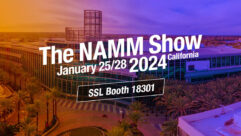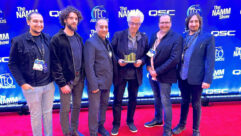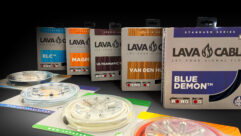
In this edition of the SVC Podcast, SVC Contributing Editor Bennett Liles talks with Eric Geer of GeerFab Acoustics in Milwaukee. Geer discusses his project to make the Anaheim Hilton’s Pacific Ballroom sound right for the Winter NAMM show and the showcase TEC Awards. He details his use of MultiZorber acoustic panel to cut sound reflections and make the job of sound mixing in the room more manageable. He also outlines his plans to do the same for the Summer NAMM show in Nashville’s Music City Center.
Links of interest:
- Acoustic consulting firm GeerFab Acoustics in Milwakee
- The National Association of Music Merchants
- More about GeerFab at NAMM
Download Podcast Here:
https://s3.amazonaws.com/nb-svc/public/public/5_13_14-GeerFab-at-NAMM_Ge…
May 13, 2014 10:32 AM,
With Bennett Liles
Listen to the Podcast

Interview with GeerFab Acoustics’ Eric Geer
Editor’s note: For your convenience, this transcription of the podcast includes timestamps. If you are listening to the podcast and reading its accompanying transcription, you can use the timestamps to jump to any part of the audio podcast by simply dragging the slider on the podcast to the time indicated in the transcription.
The big winter NAMM show this year culminated in the TEC awards with a host of sound experts in attendance, and they called GeerFab Acoustics to make sure the Anaheim Hilton’s Pacific Ballroom sounded right for that critical audience. Eric Geer is going to tell us how he got the room into acoustic shape and give us his plans for summer NAMM. That’s right here on the SVC Podcast.
Eric, it’s good to have you coming to us from GeerFab Acoustics in Milwaukee.
Correct, yes. Nice to talk with you, Bennett.
Great to have you here, and before we get into the job you did at the winter NAMM show, tell us a little about GeerFab Acoustics and what you do there.
Well, GeerFab Acoustics, I started it about five and a half years ago. You could go back to 2006. I did my first job at the Ambassador Hotel in Milwaukee and then I went out to California for a couple of years and came back and started a company in earnest. My first project was a complete acoustic renovation of the Varsity Theater at Marquette University, which was a 1,500-seat theater and a lot of RPG product went into that. And that was a great way to start a company. And then I did go into the ‘quieting noisy restaurants.’ That’s the business that friends, relatives, and colleagues had been telling me for years that I should get into and I’ve done quite a few restaurants in the Milwaukee area in Wisconsin. Hospitals, I just completed a big hospital project for Ministry Healthcare and there will be more to come there. I’ve done some recording studios, [and] of course, the Pacific Ballroom out in Anaheim. I did a museum project for the state of Wisconsin, some offices, a private residence. I had not had to market in a couple of years. The jobs keep coming. [Timestamp: 2:10]
Well, once your name and the quality of your work gets around, the people will come to you.
That’s what’s been happening, yes.
They called you to the Anaheim Hilton’s Pacific Ballroom for the winter NAMM show. Big show coming up and they had a big problem. What exactly did they need you to fix in there for the winter NAMM show?
Well, it’s a 30,000-square-foot ballroom, 21ft. ceilings, and it’s all hard surfaces except for carpet, but carpet isn’t much of an absorber; [it’s] a very narrow-band absorber. So it was a very, very lively room, [with] lots of bass buildup issues and a lot of mid- and high-frequency smacking around the room. And one thing in particular was troublesome, which was a parabolic concave surface that ran the entire perimeter of the room starting from about 7ft. or 8ft. down from the ceiling and then curving concavely back to a vertical height of, oh, 2ft. or 3ft. And that acted like a slingshot just throwing those frequencies right back at everybody, including the engineers. [Timestamp: 3:13]
It must have been a nightmare for anybody having to run sound in the place, especially for speech intelligibility at least.
It was very, very bad, and I had experience in that ballroom, but it was just coincidental that earlier that year at the winter NAMM show, the MultiZorber, which is a small-scale version of the product that I used in the ballroom – or I could say this product in the ballroom is a large-scale MultiZorber, which is probably the best way to say it. The MultiZorber, which is distributed by Hal Leonard Corp., at the retail level won best in show and it came up on an agenda item in the middle of the summer and I reminded them of that and they said, “Why don’t you tell us what we should do.” And it worked out very well. [Timestamp: 3:53]
You had several things to fix in there and I know you only had a certain time window to get in and get it all done. What was the biggest thing to do when you looked at it and said, “This is the thing that’s going to eat up most of the time and take most of the people for the job.”
Well, I was fortunate in that I was working with an incredible team. The NAMM people—Pete Johnston, in particular—and the Freeman people—Wes Lane, Mark Powell, and Scott Rogers—we went with the idea of this lightweight, 2in.-thick panel that can be made very large; it ended up being as large 4×9.5. But the task for me was to figure out where, how many, and then work with Freeman on getting them up and that particular part of it was taken care of at a December meeting onsite, mostly with Mark Powell, and we dropped everything into CAD right onsite. When I left after a couple of days there, the job was done. It was all locked up into CAD and then I was able to manufacture them and they were shipped to the NAMM Show. They arrived the Saturday before the NAMM show for the TEC Awards. And the team that NAMM and Freeman put together, it was clockwork. I just let them do their jobs and do them well. The products came in off the truck on a Sunday, they went up to the ballroom, and they simultaneously rigged up the box trusses and hung these at the same time so that you would hang a number of them on a truss, the truss would go up, and you’d move on to the next truss because everything was mapped out with CAD. These large-scale MultiZorbers, they had grommets at the top and they were attached to the box trusses with zip ties. Once you do one, you can go right on to the other. But also the rigging points in the ceiling of this 30,000-square-foot ballroom were ideally laid out for what I needed to do. The rigging points were about 1ft. off the wall so that these 4×9.5 MultiZorbers were off the wall by about 8in. or 9in., which made a nice base trap all the way around the room. Because that extra dead-air space behind this wall of absorption and bass trapping, it couldn’t have been more ideal. And there were even rigging points down the length of the hall that we had hung an additional two rows of 4’x2’ panels to stop some of the early reflections. I was very fortunate that the hall itself was ready-made for what I needed to do. [Timestamp: 6:23]
May 13, 2014 10:32 AM,
With Bennett Liles
That was a huge break. Now you used some 40 or more of the acoustic panels to get the sound of the room under control?
Oh, about 200 around the perimeter. And this is the remarkable thing about NAMM is, first of all, this was their initiative. Now that the TEC Awards had merged with NAMM, that is was important for them to present this show to the pro audio world in the best way they can. They knew that they had to tackle the room. I just happened to be there, having thought about the room for a couple of years, and just earlier that year launched this product line and just went very large scale with it. The 40 you’re referring to were the 40 4x8s that sat on the top of the stage, that lay across the trusses that built up the whole stage system with the lighting and the sound. [Timestamp: 7:10]
Tell me a little more about the acoustic hat you put in over the stage area.
Those were really large-scale MultiZorbers because they followed the same look in that they had a grommet in each corner, and that allowed them to lie flat; 40 of them—just imagine big sheets of plywood 4×8—attached to the trusses up on the stage. They, too, were secured to the trusses with zip ties. Now they weren’t going to move anywhere, really, but they were secured nonetheless, and they’re very lightweight. I think a 4×8 came in around 10 pounds. [Timestamp: 7:42]
And there were a lot of things going on that week but the awards show, the TEC Awards, was the main event and of course there was live music. But the audience for this was not just your average people off the street. These people all know sound and acoustics and that was a very critical audience to show what you could do.
It really was. And I had gotten word the Tuesday before the Friday show of the TEC Awards that it was already being extremely well received. Regarding the audience yes, that is people from pro audio, the representatives from the manufacturers, engineers, and producers. And I did get to speak to some of them and I did ask them, “Did you notice the black panels around the room,” and they said yes. I said, “That was me,” and they said, “Oh my God. it sounded fantastic.” I got a lot of compliments from colleagues who had noticed what a difference because most of the people who go to the TEC Awards have been going to the TEC Awards for some time. [Timestamp: 8:37]
And you’ve got to follow up that job now at the summer NAMM show in Nashville?
Yes. One of the ideas behind this whole endeavor is that these panels were to be taken down. It was a temporary fix, so they were boxed up using these shipping containers that are normally used for convention carpet. They were boxed up and put into storage and they’ll be shipped to summer NAMM and be deployed at the convention center. Now there is a big difference in size between the places, the Pacific Ballroom is 30,000 square feet and the exhibit space at Music City Center is, according to their information, 350,000 square feet, so about 12 times the size. We’ve not formally talked about the actual deployment, but I would imagine it would be in the drum area at first and we may or may not augment the supply that we have right now, but where we put them they will be effective. [Timestamp: 9:26]
That’s going to be a huge show and now that they’ve seen – or rather heard – what you can do, their expectations are going to be pretty high.
Yes, and I think we’ll meet their expectations. And this approach can be used on a permanent basis as well, or permanent in a sense that if a convention center wanted to use this technology it is something that can be rigged for a particular area, a particular type of convention, and then put into storage and rented out for the next convention. [Timestamp: 9:58]
Now that you’ve had the chance to actually do the job in Anaheim, you’re probably set up pretty well for anything that happens at NAMM in Nashville so what else have you got coming up?
Well, I’m making a big push on hospital work. That does not employ the MultiZorber, but a lot of different products that I use. I’m working on additions to the RoomZorber line. I will be working on getting the large-scale MultiZorbers into more large venues, conventions, nightclubs. They can go around stages at just about any music venue. One of the things that I appreciated so much about working with NAMM is that they listened to me and they gave me the opportunity to do what I thought was necessary, and that acoustic hat we talked about is something that I’ve wanted to do for awhile because at most stages, whether they’re indoor or outdoor, could use something like that. Not just a hat, but also around the stage. We couldn’t put these around the stage in this particular instance because of the way the show is set up and the week of activities is set up, but the hat did the trick. So yeah, those are areas that I would like to move the large-scale MultiZorbers in. [Timestamp: 11:00]
Well, at NAMM you’re auditioning your stuff for all the right people. Thanks for taking the time out to tell us how you tamed the acoustics at the Pacific Ballroom and what you plan to do in Nashville to get that room ready for the show. Eric Geer from GeerFab Acoustics. It was great hearing about it, Eric.
Well, thank you, Bennett. It’s been a real pleasure.










